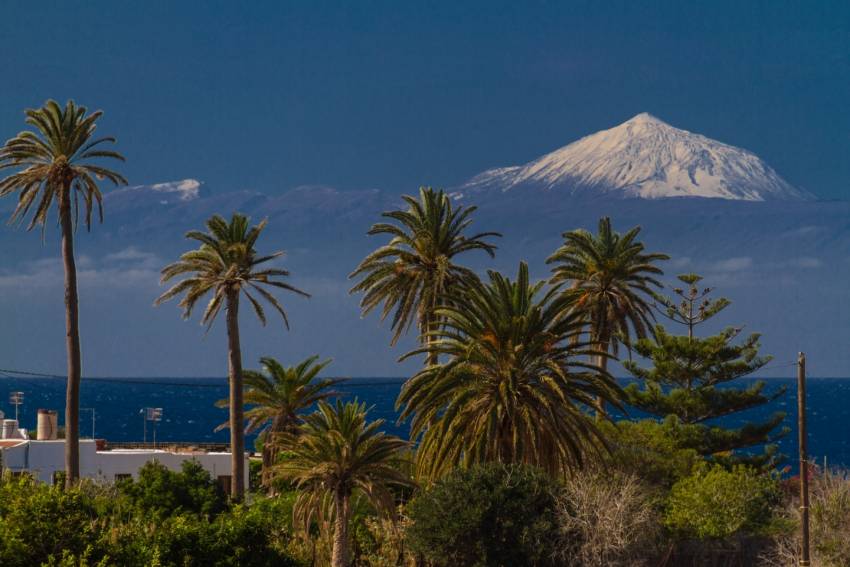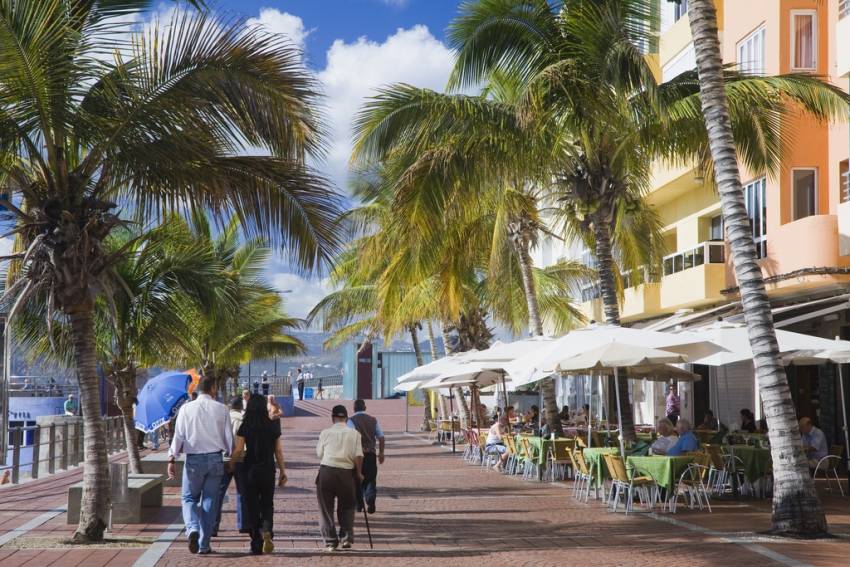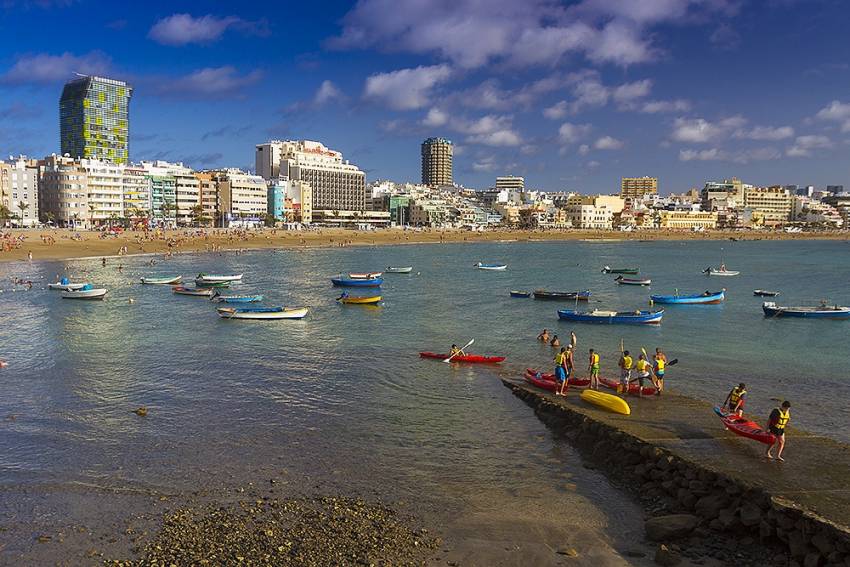Alex Bramwell
Gran Canaria Versus Tenerife: Which Island Is Better for Your Holiday
Gran Canaria and Tenerife are the two biggest tourist destinations in the Canary Islands. Since most visitors choose one island for their holidays, which is better, Gran Canaria or Tenerife?
Both islands get great weather all year round and are the same distance from Europe. We live in Gran Canaria and love the island, but Tenerife is a cracking destination as well. Here's what we think:
The Beaches
The beaches are why you guys head to the Canary Islands so let's have a look at what the two islands offer:
We think Gran Canaria has the edge because of its natural sandy beaches: Between the golden beach and dunes at Maspalomas and Playa del Inglés, and the stunning Las Canteras Beach in Las Palmas, Gran Canaria has two of Europe's best beaches. Tenerife has beautiful natural stretches of sand, such as El Medano, La Tejita and Playa Jardín, but they are not on the same scale.
When it comes to artificial beaches both Gran Canaria and Tenerife have some crackers. Las Teresitas in Tenerife is beautiful, as are Playa de las Americas, Playa del Duque and Fañabé. On Gran Canaria you have Anfi, Amadores and Mogan, all pretty beaches close to the resorts. Again, Gran Canaria has the edge, in our slightly biased opinion, due to its number and range of beaches.
Both Tenerife and Gran Canaria have excellent little beaches that rarely get any tourists. The best beaches on both islands are often the little ones at the mouth of quiet barrancos. You get the sun and the sea all to yourself! Overall, we give the beach crown to Gran Canaria.
Food and Drink
Tenerife just seems to do food better than Gran Canaria. From its little Guachinche restaurants in the hills to its quality resort restaurants, Tenerife is a cut above. There are plenty of good places to eat in Gran Canaria, especially in small towns and in the capital Las Palmas, but Tenerife still has the edge: We think it is because is more popular with French and Italian visitors and residents.
Tenerife's Dorada beer is slightly nicer than Gran Canaria's Tropical (hope nobody from Gran Canaria is reading this ;-D), even though both brews are made by South Africa's SAB Miller brewery. Gran Canaria's Arehucas rum is the Canary Islands' most popular spirit.
With Tenerife's beer topping Tropical and Arehucas carrying the spirits category we have to give the overall food and drink prize to Tenerife.
Landscapes and Nature
Tenerife has a 3,718 metre volcano and you can't argue with that: The Las Cañadas national park is unique in Europe and Teide is a stunning peak. The far north of Tenerife is rugged and spectacular and its laurel and pine forests are pristine.
Gran Canaria on the other hand has its spectacular ravines or barrancos and gorgeous pine forests, as well as the sheers cliffs of the west coast. Both islands have a huge range of outdoor sporting options such as cycling, diving and hiking. In the battle of landscapes, we think both islands come out equal.
Nightlife and Fun
Tenerife's Playa de Las Americas is the liveliest resort in the Canary Islands and beats Playa del Inglés in Gran Canaria. The famous Veronica Strip is where the young-uns head for fun after sunset. Where Gran Canaria wins out is in its local night-life: Las Palmas' bars and clubs are full most nights of the week and Santa Cruz just doesn't have the same energy. While La Laguna has a fantastic university scene, we think that Las Palmas' is better thanks to its size and diversity. With Tenerife taking the resort crown and Gran Canaria the local one, its another draw.
So which island is better, Gran Canaria or Tenerife? It's a tough call as both islands have world-class highlights, but we have to give the overall prize to Gran Canaria. But then we would: If we liked Tenerife more we would move there!
What do you think? Have we been fair? Or have we missed something that pushes Tenerife into the top spot? Let us know in a comment, or visit our Gran Canaria Facebook page.
Sabotage: The Real Reason Columbus Stopped In Gran Canaria
Christopher Columbus stopped in Las Palmas de Gran Canaria in 1492 on his way to discovering the Americas not because he wanted to, but because his crew sabotaged his ship within three days of setting sail from Spain.
The Top Ten Canarian Foods That Everybody Should Try
Canarian food is one of the highlights of a holiday in Gran Canaria. Try it in local restaurants in the capital Las Palmas or in the hill towns. The Canary Islands dishes served in the resorts are rarely any good.
Papas Arrugadas
The Canarian dish that everybody tries and most people love. Papas arrugadas or wrinkly potatoes are small potatoes boiled their skin in sea water until the wrinkle up and develop a thin crust of salt. They are served covered with Mojo Picon, a spicy sauce made of olive oil, cumin,chili peppers, raw garlic and vinegar. The Canarian word of potato is papa, which also means pope. Some mistranslated English menus describe papas arrugadas as “wrinkly popes”!
Gofio
The staple diet of the pre-Hispanic indigenous Canarians, who did not survive the Spanish colonisation of the island, gofio is a nutritious flour made from pre-roasted barley or maize. Add it to coffee for a stomach-lining breakfast or try gofio escaldado, a sort of thick porridge flavoured with mint and eaten with raw red onions. Gofio is an acquired taste!
Sancocho Canario
A festival dish that is served on Sundays and at local Romerias (Canarian fiestas), Sancocho is a stew made from salted cod fish and sweet potato. Sancocho is traditionally served with pella de gofio, a soft paste made out of roasted maize flower and water. Sancocho is various forms can be found all over South America but the Canarian version is the original.
To be perfectly honest sancocho is incredibly fishy and salty and hardly anyone who isn't Canarian likes it.
Tropical Fruit
The subtropical climate of Gran Canaria means that it is one of the only places in Europe that can grow tropical fruit. Mangos, papayas, cactus fruit (tunos), pineapples, guavas, water melons and of course bananas are all grown locally and can be found in the main shops and markets. Canarian bananas are smaller than Caribbean ones and much tastier!
Ropa Vieja
Literally translated as “old clothes”, ropa vieja is a tasty stew made from chickpeas and chicken or beef, flavoured with bay leaves. Traditionally it was made from the meat leftover after making soups. There is a local myth that ropa vieja was invented by a man so poor that he made soup out of his clothes, which turned into this delicious dish.
Potaje
A thick and tasty vegetable soup made from potatoes, corn cobs and mixed vegetables, often with lots of watercress in it. Potaje is a good option for vegetarians. Most local restaurants make a different potaje every day.
Carne de Cabra
There is nothing better than slow-cooked, fatty goat meat served in huge portions. While lots of people think goat meat has a very strong taste, the Canarian way of stewing it on the bone makes it juicy and delicious.
Pata Asada
A staple snack, pata asada is roast pork, served cold sprinkled with sea salt. Done well it is moist and addictive! Done badly, it is shoe leather!
Squid and Octopus
There aren't many crabs and lobsters around Gran Canaria but there is plenty of squid, octopus and cuttlefish and Canarian cooks do them all justice. Squid is fried in rings (calamares fritos) and soaked in lemon juice and octopus is sliced thinly and served covered in sea salt and paprika (pulpo a la Gallega). Tiny squids are deep fried and served whole (puntitas de calamar) while cuttlefish are stewed with potatoes (choco en salsa)
Deserts
Truchas de batata are similar to turnovers and are filled with sweet potato while huevos mole is thick custard flavoured with lemon peel and cinnamon. With any desert, ask if it is home made (casero) to avoid disappointment. Mazapan is dense shortcake made from almond flour that is sold in the mountain villages.Also don't miss Guarapo, a sweet, almost black syrup made only on La Gomera from palm tree sap.
Is Gran Canaria A Safe Holiday Destination?
You might expect a volcanic island close to the Sahara desert to have its fair share of dangerous animals and freak weather.
Could a Canary Island Mega Tsunami Destroy New York Tomorrow?
The ridiculous story about an imminent tsunami caused by the collapse of La Palma in the Canary Islands just won't go away. Here's why it's nonsense.
Gran Canaria: Restaurant Daily Menus
You never see a Canarian rushing down the high street juggling a half-eaten bocadilllo and a plastic cup of takeaway coffee. That's because of the venerable tradition of the Menu del Dia.
Las Palmas de Gran Canaria: Europe's Latino City
A city destination with miles of golden sand, bars serving local rum, a raucous month-long carnival and Christopher Columbus' house. The legendary Habana perhaps, or Colombia's exotic Cartagena de Indias? You might be surprised to find out that this exotic destination is much closer to home. Las Palmas, Europe’s secret Latino city, is just four hours flight from Britain and Germany.
Las Palmas is one of the biggest cities in Spain, boasts the best city beach in Europe and still parties like it's 1999. Its old town district is on the short-list to become a World Heritage Site and its shops are among the cheapest in Europe. Las Palmas is 'the city with the best climate in the world' according to New York's Syracuse University. Average temperatures range between 20 degrees in the winter and 26 degrees in the summer. It receives six hours of sunshine every day during the winter, ten hours in the summer.
By rights Las Palmas should be overflowing with tourists but somehow it has slipped under the radar. Overshadowed by the huge, package-tourist resorts in the south of Gran Canaria, the city hardly caters to visitors. There are no rep-led pub crawls or time-share salesmen in Las Palmas.
In February, the annual carnival takes over the city for a whole month of parades, parties and concerts. No other European city can match Las Palmas' blend of Spanish and Latino culture. Sometimes, it is like a small chunk of Cuba floated across the ocean and nobody noticed.
Las Canteras Beach Guide: How To Choose A Spot
Las Canteras beach, a 3.5km of golden sand that sweeps down one side of the city, is the jewel of Las Palmas. It's so big that each section has its own name and character. Here're the main areas from north to south.
The Top 20 Best Beaches in Gran Canaria
Gran Canaria has dozens of beaches, from the Saharan splendour of Maspalomas to the tiny patch of sand at Sardina del Norte. Some are packed with sun loungers and parasols, while others are hours away from the nearest Full English Breakfast. Whatever your taste, the island has the perfect beach for you.
Five Cool North Gran Canaria Beaches The Locals Keep to Themselves
There are quiet local beaches dotted all around the north coast of Gran Canaria. If you get sick of long sand beaches covered in sun loungers and parasols then head to one of these secret spots. All of them are great for snorkelling.
Gran Canaria Info recommends:
- Default
- Title
- Date
- Random






















